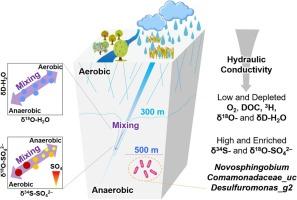利用多种同位素和微生物指标评估断裂天然屏障系统地下水补给区的放射性核素流动性
IF 12.2
1区 环境科学与生态学
Q1 ENGINEERING, ENVIRONMENTAL
引用次数: 0
摘要
铀(U)浓度高达 322 微克/升,其分布与天然屏障系统(NBS)内的裂缝形态相关。对溶解氧(DO)、溶解有机碳(DOC)、氚(3H)、微生物群落以及 H2O 和 SO42- 同位素的垂直分布分析揭示了异质断裂系统中的缺氧水渗透情况。SO42-同位素表明,微生物的硫酸盐还原作用有可能在深部地质系统中起到调节放射性核素流动性的作用。在约 500 米处,发现了能够在低溶解氧和高重金属浓度的恶劣条件下生长的菌属,如新磷酸盐菌属、科莫纳藻属 (Comamonadaceae_uc) 和脱硫单胞菌属 (Desulfuromonas_g2)。这些发现表明了深层 NBS 中的水文地质变异性和微生物适应性,突出了了解深层地质环境对于评估微生物组在调节储存库系统内有毒放射性核素方面的性能的重要性。总之,这项研究强调了年龄示踪剂、稳定同位素和微生物组在加强断裂花岗岩屏障长期稳定性评估方面的关键作用。本文章由计算机程序翻译,如有差异,请以英文原文为准。

Evaluating radionuclide mobility in groundwater recharge areas of fractured natural barrier systems using multiple isotopes and microbial indicators
The distribution of uranium (U) concentrations, which reached up to 322 µg/L, was found to correlate with the pattern of fractures within the natural barrier system (NBS). Analysis of the vertical distribution of dissolved oxygen (DO), dissolved organic carbon (DOC), tritium (3H), microbial communities, and H2O and SO42– isotopes revealed insights into oxic water infiltration within the heterogeneous fractured system. Their distribution showed that the average infiltration depth at the KURT site is 200 m, while in external areas with a high frequency of fractures, oxic conditions extended down to 495 m. The SO42– isotopes suggested the potential for microbial sulfate reduction to play a role in regulating radionuclide mobility in the deep geological system. At approximately 500 m, genera capable of thriving under harsh conditions of low DO and high heavy metal concentrations, such as Novosphingobium, Comamonadaceae_uc, and Desulfuromonas_g2, were identified. These findings indicate hydrogeological variability and microbial adaptation within the deep NBS, highlighting the importance of understanding the deep geological environment for evaluating microbiome performance in regulating toxic radionuclides within repository systems. Overall, this study emphasizes the pivotal role of age tracers, stable isotopes, and microbiome in enhancing the assessment of the long-term stability of fractured granite barriers.
求助全文
通过发布文献求助,成功后即可免费获取论文全文。
去求助
来源期刊

Journal of Hazardous Materials
工程技术-工程:环境
CiteScore
25.40
自引率
5.90%
发文量
3059
审稿时长
58 days
期刊介绍:
The Journal of Hazardous Materials serves as a global platform for promoting cutting-edge research in the field of Environmental Science and Engineering. Our publication features a wide range of articles, including full-length research papers, review articles, and perspectives, with the aim of enhancing our understanding of the dangers and risks associated with various materials concerning public health and the environment. It is important to note that the term "environmental contaminants" refers specifically to substances that pose hazardous effects through contamination, while excluding those that do not have such impacts on the environment or human health. Moreover, we emphasize the distinction between wastes and hazardous materials in order to provide further clarity on the scope of the journal. We have a keen interest in exploring specific compounds and microbial agents that have adverse effects on the environment.
 求助内容:
求助内容: 应助结果提醒方式:
应助结果提醒方式:


